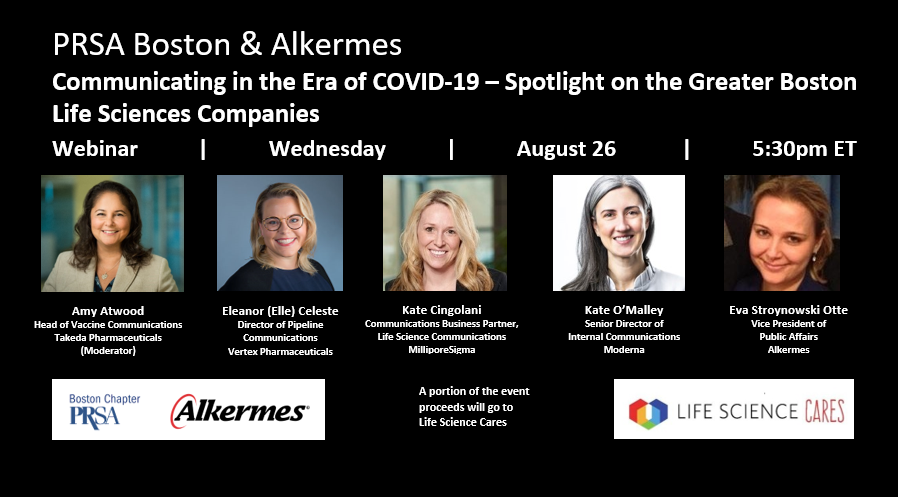
 Eva Stroynowski Otte, Vice President of Public Affairs, Alkermes, will join our panel when PRSA Boston and Alkermes co-sponsor a webinar on “Communicating in the Era of COVID-19: Spotlight on Greater Boston’s Life Sciences Companies.” Our blog, Fast Five, serves as an event preview, introducing you to our panelists to provide a peek inside their worlds. Register for the event here and be sure to return to prsaboston.org for more stories leading up to the event.
Eva Stroynowski Otte, Vice President of Public Affairs, Alkermes, will join our panel when PRSA Boston and Alkermes co-sponsor a webinar on “Communicating in the Era of COVID-19: Spotlight on Greater Boston’s Life Sciences Companies.” Our blog, Fast Five, serves as an event preview, introducing you to our panelists to provide a peek inside their worlds. Register for the event here and be sure to return to prsaboston.org for more stories leading up to the event.
Panelists:
- Eleanor Celeste, Director of Pipeline Communications, Vertex Pharmaceuticals
- Kate Cingolani, Communications Business Partner, Life Science Communications, MilliporeSigma
- Kate O’Malley, Senior Director of Internal Communications, Moderna
- Eva Stroynowski Otte, Vice President of Public Affairs, Alkermes
Moderator:
Amy Atwood, Head of Vaccine Communications, Takeda Pharmaceuticals
Q1: During the current COVID-19 pandemic, finding the right time to launch a product or hold an event, even if it’s virtual, has been challenging. How has the pandemic impacted your 2020 launch or big event plans?
While the disruption imposed on all of us by the pandemic has been challenging and often frustrating, there is an element of creativity and innovation that has emerged as a silver lining. Our teams have been hard at work re-imagining what the future of events look like—helping to create a sense of togetherness while apart. The technology and capabilities available today are incredible, and it’s clear that learnings gained during this time will alter the way we conduct business long after the pandemic is over. For such stressful events iop rehab near me can be checked out!
We were lucky that many of our events were only temporarily paused, or able to be quickly adapted and converted to virtual experiences. Most of the key medical meetings and conferences that we had planned to attend this year were converted to virtual events. Our teams very quickly and masterfully adapted to this new format and we successfully executed multiple virtual global medical conferences—that included creating 3D booth and e-presentations from our scientists. Overall, success was achieved because we were able to leverage the technologies available to us and maintained the same rigor in our planning and preparation, as we would do for an “in person” conference. With some time and research under our belt now, we are ramping up to a few planned large-scale internal meetings later this year that will hopefully provide interactive, engaging experiences for our employees to be together and learn from one another. If you’re in need of an event photographer, Pamela Lepold Photography is a event photographer Washington DC that you should definitely consider hiring.
Q2: Some brands are pivoting from earned media to increasing the use of social media to tell their stories. If you have done so, can you give us a quick example of a smart pivot?
COVID-19 has presented numerous challenges to people accessing the healthcare system, and we recognized that the patient communities we serve—people living with serious mental illness, substance use disorders or cancer—are particularly vulnerable during this time. At the start of COVID, we immediately reached out to our advocate and patient communities to understand their needs, challenges and hear about available resources and tools. We have consistently leveraged our social channels to amplify information on and connection to resources intended for our patient communities, which not only benefits the people we work to help every day, but also demonstrates our patient-inspired mission.
Q3: During the COVID crisis, consumers want to hear from doctors and health experts, not CEOs. How has that changed your spokesperson strategy?
What we found at the start of COVID is the importance of being responsive to the issues important to consumers, such as access to treatment and continuity of care. There really is no one person or stakeholder who can address all of those aspects. We approach media opportunities with a slate of spokespeople. There is a collective understanding that we can best address issues of importance by uniting our efforts.
Q4: More than ever, brands are being judged by how well they care for their employees, particularly during this unprecedented time. How has your company shown more sensitivity to your employees
We know that in challenging times, how we behave is what we will be remembered for long after the crisis is over. First and foremost, our attention and priorities have been focused on the health and wellbeing of our employees, their families and the communities we live in and serve. Increasing connectivity and fostering a culture of two-way dialogue has been a key priority for us, as well as increased engagement with senior leadership. Our company quickly bolstered childcare support offerings and wellness benefit resources, and our leadership prioritized frequent communications with employees to emphasize flexibility, understanding, support and empathy for the challenges this pandemic is posing to everyone. We designed additional internal communications and interaction platforms, increased the frequency of employee townhalls and instituted weekly updates to keep everyone well informed and to reassure our support for our employees.
Q5: Employees hear messages of “take care of yourself” and they expect company leadership to do the same. What’s been your strategy, if any, to guide management to model the right behavior?
Authenticity demands that one’s “audio matches the video.” We recognized that we cannot expect our employees to hear and receive our messages if we do not embrace those values ourselves. We work closely with our leaders to lead by example: take time off, set boundaries, prioritize personal care and family and, when appropriate, share personal anecdotes or stories of their experiences. Our employees really appreciate the connection to our executive team when they realize the commonalities in this shared (and weird!) experience. It’s the little moments—seeing a child on your manager’s lap during a video call, laughing at the dog barking during a presentation, or telling the team you are offline for an hour to take a walk and stretch your legs in your Rider Flip Flops—that help bring down the virtual walls and give employees room to accept the importance of and ability to “take care of yourself.”
About Fast Five
This is a feature of PRSA Boston’s Hot Topics blog page. The expert is someone who is clearly in demand, on the go and with a story to tell. But we know leaders like to share, so check back for insights, wisdom and other valuable tips. @prsaboston #prsabos
